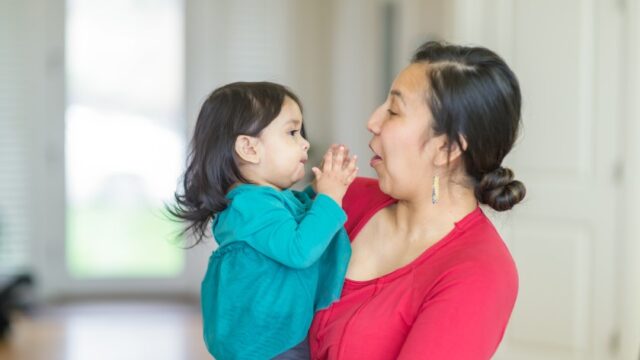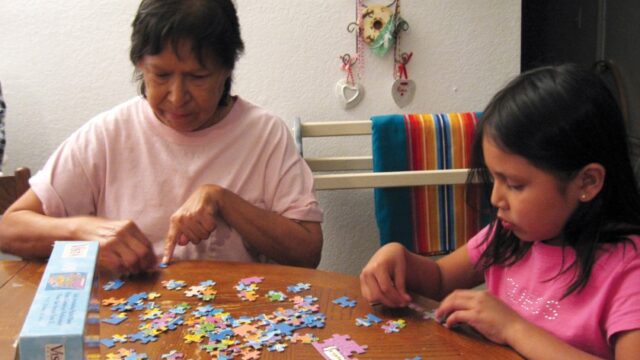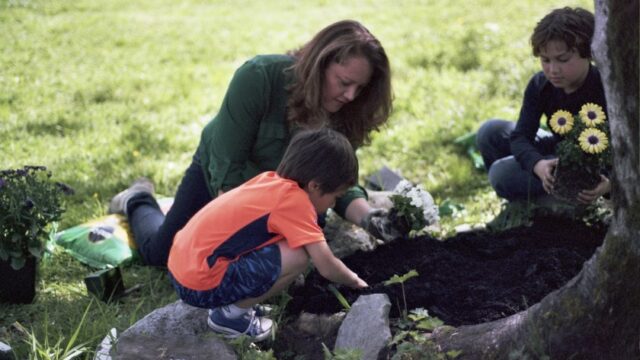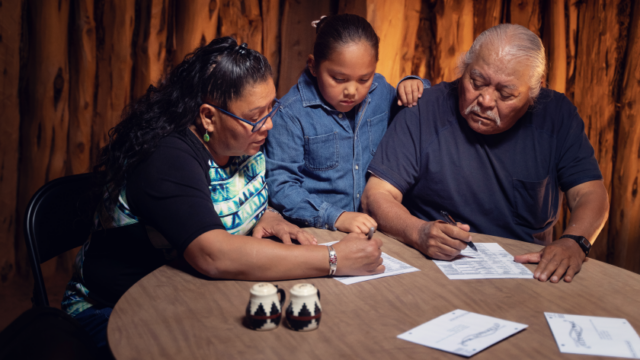Tip Sheet
How Relative Caregivers Can Advocate for Relative Native Children in State Child Welfare Agency Custody
Download This Resource

Extended family members and close family friends, sometimes in a fictive kin role, are important resources to families encountering the child welfare system due to a report of child maltreatment. This can be a scary time for children, birth family members, extended family, and close friends. Often, the family group may not have had any prior experience with the child welfare system and faces the need for immediate information to navigate the system precisely as their family is under severe stress and perhaps even in crisis.
This resource is a starting place for that journey. It provides a summary of how relative caregivers can be involved at different stages as the child welfare system decides:
- Whether to investigate the maltreatment report,
- Whether to substantiate a report if the investigation shows evidence of abuse or neglect, and
- Whether to remove the child from their home for placement in out-of-home care.
Along the pathway of these decision points, there will also be decisions made about what services and supports to offer the family and child.
The National Indian Child Welfare Association developed this resource as a tip sheet that tribal service providers can give to people who are seeking to become a caregiver for a minor relative child or seeking to provide support to and/or advocate for a minor relative child in an out-of-home placement.
This tip sheet uses the terms “relative caregiver” and “relative child” to refer to adults and children, respectively, who are connected to each other by kinship bonds, whether as extended family members or close friends. Relative caregivers may raise relative children whose parents are unable to do so.
A growing body of research shows that when a child has to be removed because of abuse or neglect in their home, they will have the best short- and long-term outcomes when placed with people they know – extended family or close family friends. This resource answers three key questions that extended family and close family friends may have:
- How can family members or friends advocate for their relative child throughout this process?
- How can family members/friends advocate to be a placement for their relative child?
- If family members/friends are not able to be a placement for the child, how else can they be involved?
Below are tips for family advocacy at each decision-making step in the child protective services process. See the flowchart on page 8 of the “How the Child Welfare System Works” fact sheet from the Child Welfare Information Gateway for a sample illustration of how most state child welfare systems operate.
Maltreatment Report
Mandatory reporters and/or members of the general public may report suspected child abuse or neglect. As suggested by the title, mandatory reporters include educators, medical professionals, law enforcement, and social workers who are required by virtue of their profession to report suspected abuse or neglect through a call to a hotline or other means, depending on state law. When a maltreatment report has been received, Child Protective Services (CPS), a service unit within a broader state, county, or tribal child welfare agency, will decide whether the allegation of abuse or neglect warrants an investigation into whether there are immediate safety concerns that threaten the well-being of the child.
Investigation
For American Indian/Alaska Native children, a federal law called the Indian Child Welfare Act (ICWA) includes additional protections to keep children safely with their families when possible. For Native kids, even if they aren’t currently enrolled with a federally recognized tribe, relative caregivers can inquire as to whether the investigation included questions about the possibility of the child’s Native heritage. The potential for Native heritage should be explored with multiple parties and families who may have relevant information, and all available information about that heritage should be documented, even if it is not confirmed.
Relative caregivers can also ask whether the risk and safety assessment included an assessment of strengths – of the family, the child, and the environment – in addition to documenting safety concerns. You can help to identify natural helpers and supports, or other informal services or practices, and ask that they be included in the report. You can clearly identify your capacity to help with the range of things that you can. If your ability to provide direct care is limited, you can be a “connector,” helping to identify and connect other resource people who can support the child and family.
By federal law – the Fostering Connections to Success and Increasing Adoptions Act of 2008 – the child welfare agency must conduct a diligent search for the child’s adult relatives. You can help to document the family tree and identify relatives, including fictive kin and other adults with whom the child may have a relationship. It is essential to identify as many relatives and other adults with meaningful relationships to the child as possible. This may be the pool of people who are contacted and/or asked to give input or provide support for the child and/or family throughout the duration of the child custody case.
Decision to Substantiate Maltreatment or Not
At the conclusion of the investigation, CPS will decide whether to substantiate the claim of child abuse or neglect. At this decision point, you can advocate for a family group meeting, an opportunity to convene the extended family and other resource people to focus on child safety and family support. If the maltreatment report is substantiated, a family group meeting may inform a case plan to ensure safe care of the child and remedy any safety issues or concerns with the family or in the environment. Family group meetings, convened either by the child welfare agency or informally by the family with other people who can potentially serve as resources and supports to the family, may be helpful throughout the series of child custody proceedings. While now practiced in many mainstream child welfare agencies, Native families have held these types of gatherings for thousands of years to determine how they can work together to meet children’s needs.
Placement
If CPS substantiates the claim of child abuse or neglect, the caseworker will decide whether services can be provided to the family, who can continue to care for the child safely at home, or whether the child will need to be removed from the home and placed in an out-of-home placement to ensure their safety.
If the child welfare agency determines that ICWA does apply to the case and the child needs an out-of-home placement, a hierarchy of placement preferences apply, and family members (both Native and non-Native family) are the first placement preference. See NICWA’s A Guide to Compliance with the Indian Child Welfare Act for more information. If ICWA does not apply to a case, other federal laws, like the Fostering Connections to Success Act, also require a diligent relative search and placement with family as a first option. It is increasingly widely recognized that children who suffer the trauma of being removed from their family should – if at all possible – be placed with family or caring adults that they know.
As a relative and advocate for the child and family, it may be helpful to agree to submit to a background check to be a resource in the case, especially if you can be a placement for the child if necessary. You may also volunteer to participate in child welfare agency meetings (as permitted) and court hearings. (See the general advocacy recommendations below.) This will help you to have current information about the stage of the case and what will happen next as well as signal to the agency and court that the child and family have support.
In the event that CPS substantiates maltreatment and requires an out-of-home placement, you can advocate for early and consistent parental visitation. You can also advocate to visit your relative child. If the child is placed in foster care with people the child does not know, you may be able to be a resource for the foster parents by providing support to help them understand the family history and the child’s experiences. You may be able to be an informal helper, supporting the foster family in providing the most appropriate care for your relative child as well as having a regular connection with them.
Generally speaking, an out-of-home placement with relatives or a foster family lasts until the birth family has addressed the safety concern(s) outlined in the case plan that led to the out-of-home placement in the first place.
General Advocacy Tips
Children who are at risk of being removed from their families, or who have been removed, need to know that there are family members and caring adults who are concerned about them and play a role in meeting their needs and nurturing them, whether those adults can be an out-of-home placement for the children or not. Even if you cannot be a placement for a relative child, you can be an advocate for them in ways mentioned earlier, including but not limited to participating in family team meetings, identifying other placement resources, providing cultural outreach or support, providing respite, providing transportation to services, etc.
Early involvement in the child protective services process and building relationships with people working with your relative child and family are key. Establish yourself as someone that service providers can count on to support the child by being a collaborative problem-solver concerning efforts to meet the child’s needs. Especially when working with a state worker, if you are aware of resources the child’s tribe may provide, inform the caseworker that such resources are available.
Nurture a relationship with the case worker. Make sure they know about your interest in the child, ways that you can be helpful to the child, and your ability to be a placement if applicable. Help identify other extended family and caring adults, both as part of the nurturing network that can help to support the family and keep the child safe and as possible out-of-home placements should the child require one.
Relatives may end up not being a party to the case in a legal sense and, as such, may not be able to access records in the case. It’s still a good idea to keep your own file of whatever documentation you have, and you can check with the court to determine whether you can submit documentation for the court record.
One of the best ways to ensure the court has the necessary information is to ensure that the caseworker or guardian ad litem (GAL) or court-appointed special advocate (CASA) has the information that needs to be shared with the court. It may even be possible to write a letter to the court to be shared by the GAL/CASA so that the family’s voice can be heard if they weren’t allowed in the hearing or involved in developing the case plan.
If you have difficulty working with the caseworker assigned to the case, it may be helpful to reach out to the caseworker’s supervisor. That may create additional difficulty in working with the caseworker, so you should be sure you’re ready to take that step before you do. Sharing any concerns with the child’s GAL/CASA may also be helpful. Finally, many states have an ombudsman’s office, which may take and investigate complaints about the caseworker’s or agency’s actions. Making a complaint to the ombudsman is usually a last resort. To search for your local ombudsman, go to www.childwelfare.gov/resources/states-territories-tribes/related-organizations/, then scroll down use the search feature to look for contact information for an ombudsman or and ombudsperson in your jurisdiction.


